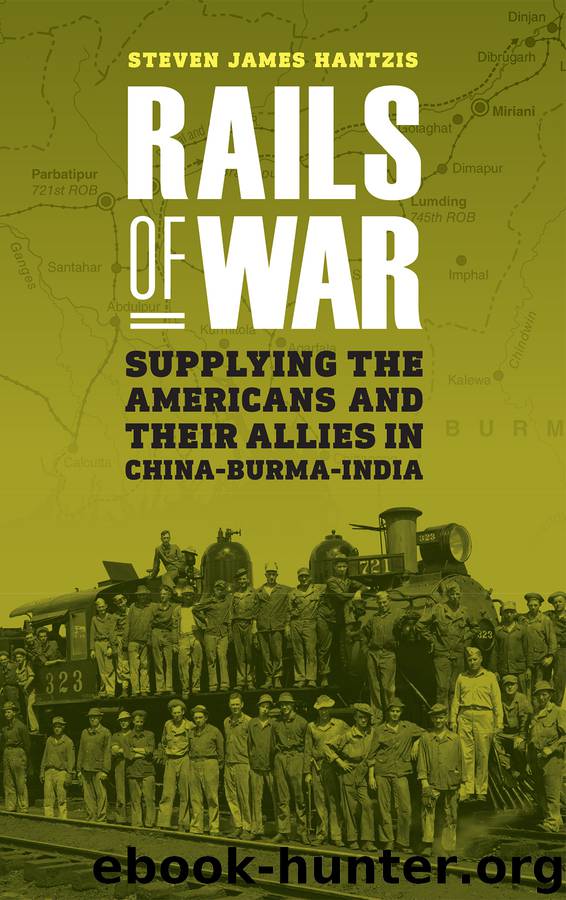Rails of War by Steven James Hantzis

Author:Steven James Hantzis [Hantzis, Steven James]
Language: eng
Format: epub
Tags: HIS027100 History / Military / World War Ii, BIO008000 Biography & Autobiography / Military
ISBN: 978-1-61234-937-4
Publisher: University of Nebraska Press
Published: 2017-03-14T16:00:00+00:00
The driving was relatively smooth for the next week. The convoy was in Chinese-controlled territory now, and the road was well maintained. The lush green countryside of Burma gave way to the often desolate red and gray hills of Yunnan. The convoy first transited the Mekong River, snaking down its gorge and up the other side, but the Mekong was just a preview of coming attractions. The last big thrill was negotiating the Salween River Gorge, where Maj. John Ausland, an old China hand who had traveled extensively in Yunnan Province, compared the crossing to “going down the Grand Canyon and up the other side.”5 Drivers first descended 2,000 feet through thirty-five staple-curve turns, crossed a suspension bridge high above the raging river, then climbed out of the chasm in low gear, all the while praying not to add their rig to the wreck-littered junkyard far below.
On the night of February 3 the convoy slept at Lake Tien Chih, just outside of Kunming. They were high in the mountains and it was cold. The next morning the Chinese drivers took over the lead trucks, with George seething all the while and Bernie still nodding.
All 110 vehicles rolled into Kunming, with Pick in the lead Jeep standing and waving his stick as they crossed a yellow-ribbon finish line at the city’s West Gate. Pick hadn’t lost a single truck. At the ribbon the general was greeted by the provincial governor, Lung Yun, a Japanese confidant, who presented him with a silk banner imprinted with the Chinese characters for “The Road to Victory.”6 That evening Lung staged a banquet with Lily Pons, the Franco-American opera star, and her husband and conductor, Andre Kostelanetz.
The first convoy—the first official convoy—to break the Japanese blockade had arrived. The Ledo Road was a success and would soon begin delivering substantial tonnage over a 14,000-mile supply line running from the West Coast of the United States through India and Burma to Kunming, China. It was the longest line of communication ever maintained in war, and everybody did their part, especially America’s soldier railroaders, to make it happen.
Old Chiang Kai-shek even had a change of heart and graciously suggested that the Ledo Road be renamed the Stilwell Road. Vinegar Joe, it can be assumed, was not overly thrilled.
. . .
On the day the convoy arrived in Kunming another convoy of sorts gathered in a town on the northern shore of the Black Sea, Yalta. This convoy was made up of political heavyweights, and their meeting in the Crimean city would be the final rendezvous of the Big Three: Franklin Roosevelt, Josef Stalin, and Winston Churchill.
The Soviet Army had reached the Oder River and was preparing for the final attack on Berlin. The day before the conference was to start, Stalin was so confident of his military position that he ordered his defense chief, Marshal Georgy Zhukov, to hold his forces in place while the week-long conference was in session.
Stalin’s liberation of Poland was now complete. In July 1944
Download
This site does not store any files on its server. We only index and link to content provided by other sites. Please contact the content providers to delete copyright contents if any and email us, we'll remove relevant links or contents immediately.
| Afghan & Iraq Wars | American Civil War |
| American Revolution | Vietnam War |
| World War I | World War II |
Waking Up in Heaven: A True Story of Brokenness, Heaven, and Life Again by McVea Crystal & Tresniowski Alex(37708)
Empire of the Sikhs by Patwant Singh(23015)
We're Going to Need More Wine by Gabrielle Union(18997)
Hans Sturm: A Soldier's Odyssey on the Eastern Front by Gordon Williamson(18526)
Leonardo da Vinci by Walter Isaacson(13227)
The Radium Girls by Kate Moore(11964)
Tools of Titans by Timothy Ferriss(8297)
Educated by Tara Westover(7990)
How to Be a Bawse: A Guide to Conquering Life by Lilly Singh(7425)
Permanent Record by Edward Snowden(5791)
The Last Black Unicorn by Tiffany Haddish(5597)
The Rise and Fall of Senator Joe McCarthy by James Cross Giblin(5244)
Promise Me, Dad by Joe Biden(5109)
The Wind in My Hair by Masih Alinejad(5055)
A Higher Loyalty: Truth, Lies, and Leadership by James Comey(4901)
The Crown by Robert Lacey(4755)
The Iron Duke by The Iron Duke(4317)
Joan of Arc by Mary Gordon(4049)
Stalin by Stephen Kotkin(3911)
